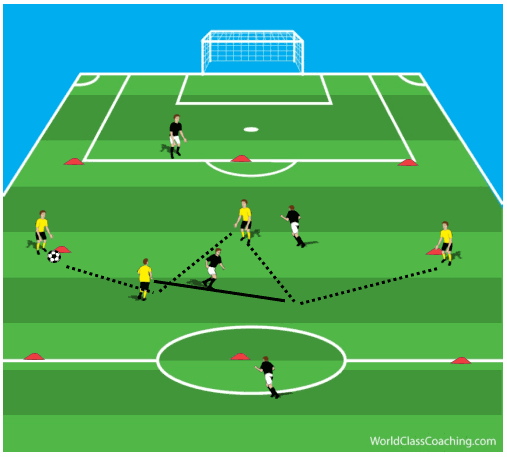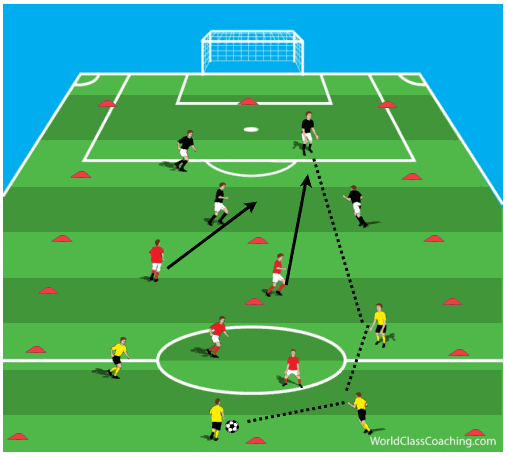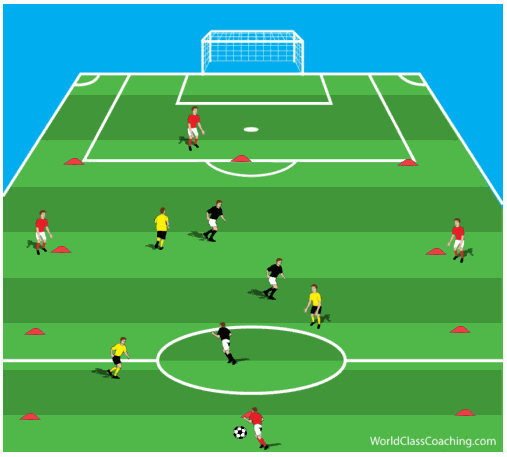By Eric Clermont -
When developing a possession based style at the youth level (as I have done over the last few years), I believe that the focus on always needing to play short becomes predominant for many teams. While there are clear pros to this, players are often given only the technical tools to play this way and no tactical context in order for them to be successful. We are not talking here about the wins and losses column, but specifically about their ability to keep possession when ‘trapped’ on one side of the field and the understanding of when to ‘open up’ the play and switch the point of attack. In the modern professional game, the ability to play out of tight pockets into areas of space is a must. Teaching players early with the simple but effective practices below will put them on the right path.
Warm Up
Organization
Players pass around with one ball in group of 4. 2 play in the middle with 2 on the outside. Keep switching roles. Work through combining through the 2 central midfielders in the middle to switch to the other side. 2 sets of players work in one box (one team going horizontally and the other going vertically), but are unopposed to add some difficulty. Coach can teach certain patterns for players to practice.
Progression
Players can switch positions with outside players after playing the ball outside. Active Recovery- Coaching points while players do dynamic stretches.
Coaching Points
- Technical decisions of passing/dribbling and combining
- Speed of play and body shape when switching point of attack
- Angles and distances of support for the player with the ball
- Ensure players are never in a straight line (always at an angle to the player with the ball)

Small Sided Game
Organization
Opposed exercise on switching the point of attack. Players split up into fours (3 teams if possible, but defensive team can have less). Field split into two 15 x 15 yard grids at each end and a 5 x 15 yard narrow channel in the middle for the defensive team. A team must play five passes and then switch to the other side for a point. Team in the middle must send 2 defenders for a 4 v 2. When they win the ball, they win a point. Continue for 3 minutes and then switch the team in the middle.
Coaching Points
- Technical aspects of short and long passing
- Combinations to create space
- Movement and creating angles/distances for player to switch the ball to other side
- Decision making of whether to play short/long
- Team on opposite side get into attacking shape early in order to keep possession when ball is switched

Extended Activity
Organization
Three central midfielders work to work together to change the point of attack by using the outside backs/ wingers on the side and the centre back and striker on either side. Server plays a ball into the box where the 3 midfielders and CB and ST work to establish a rhythm and tempo in a 7 vs. 3. Players on outside play 2 touch and must play inside, forcing 3 midfielders to create passing lanes. Switch the point at least once, play a two player combination and play in to opposite target to score. If red team win possession, they reload through one of the targets and attack towards the other side.
Coaching Points
- Change the rhythm and tempo of the play with short and long passes
- Decision whether to penetrate 1 v 1 or to combine with neutral player
- Outplaying your direct opponent. Body shape to receive (open)
- Vision and awareness to see both short and long options
- Rotation and shape of the midfield triangle in support of the wide and deep players to create space and passing lines
- Speed of play when attacking- less touches and more penetrating passes

By Eric Clermont - NSCAA Premier Diploma, USSF A License Candidate


